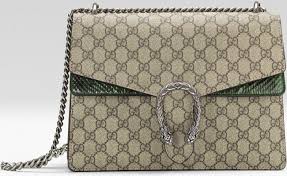 Designer handbags and shoes are most often made from leather, which can contribute to environmental problems. Raising cattle for leather consumes large amounts of land and water. Leather tanning uses heavy metals, such as chromium, and creates health hazards. PVC, which is often used to make handbags, can harm the environment.
Designer handbags and shoes are most often made from leather, which can contribute to environmental problems. Raising cattle for leather consumes large amounts of land and water. Leather tanning uses heavy metals, such as chromium, and creates health hazards. PVC, which is often used to make handbags, can harm the environment.
Some luxury accessories labels are switching to more environmentally friendly sourcing and processing of materials, but they are not necessarily using these changes as a selling point. Gucci has been integrating more environmentally friendly materials in its handbags. Its Dionysus shoulder bags use polyurethane instead of PVC. However, it does not highlight that fact in its marketing.
In 2012, LVMH created LVMH Initiatives for the Environment to promote sustainability among its fashion brands. It created a carbon fund that brands pay into based on their energy use. The money is used for projects such as upgrading to LED lighting.
Kering issued its first Environmental Profit and Loss Report in June. It studied the company’s effects on the environment by suppliers in many countries in an effort to identify and fix problems.
Luxury labels have begun to focus on the environment because of pressure from executives, shareholders, NGOs, employees, changing legislation, and public sentiment. Many brands see it as a good business practice.
Luxury brands have more control over production than other companies because they control more of the supply chain, such as tanneries. They also have the money to conduct research and develop new production methods. Luxury brands promote their products for their longevity, and their customers are less price-conscious.
Paris recently hosted the United Nations Conference on Climate Change. Delegates from 195 countries negotiated an agreement to promote sustainability and fight global warming. Executives from Kering, Gucci’s parent company, sat on several panels. LVMH Moet Hennessy Louis Vuitton was a corporate sponsor of the conference.
Fashion schools are teaching students about production chains and carbon footprints. Green fashion contests are encouraging designers to produce stylish and environmentally friendly clothing and accessories. Many millennials have said that they want sustainable fashion.

Leave a Reply